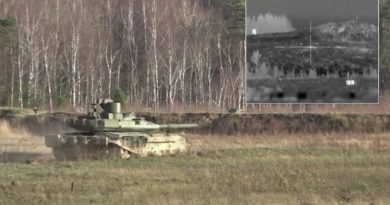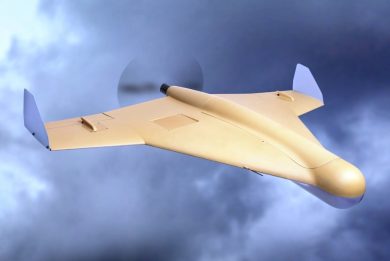Dubai Airshow 2025 – UEC unveils its first small-size turbojet engines for UAVs and cruise missiles.
One of the new products at the Russian pavilion at Dubai Airshow 2025 is a line of small-size turbojet engines (TRJs) with a thrust range of 40 to 150 kgf, as well as the RH50 turbogenerator, presented by the United Engine Corporation (UEC)
These units, which have been in production since 2024, are integrated into various types of Russian UAVs and small cruise missiles, and can also be used in advanced next-generation aircraft.
The R1 small-size turbojet engine is 520 mm long, 230 mm in diameter, has a dry weight of 18 kg, a maximum thrust of 150 kgf/1.47 kN, and a specific fuel consumption of 1.2 kg/kgf x hour (122.4 kg/kN x hour). The engine has a 100-hour TBO (Test Between Overhaul) and a 300-hour assigned service life. The starter-generator has a 3 kW rating and is spark/pyrotechnically ignited.
The compact R40 turbojet engine is 350 mm long, 152 mm in diameter, has a dry weight of 4.5 kg, a maximum thrust of 40 kgf/0.39 kN, and a specific fuel consumption of 1.2 kg/kgf x hour (122.4 kg/kN x hour). The engine has a 100-hour TBO (Test Between Overhaul) and a 300-hour assigned service life. The starter-generator has a 1 kW rating and is spark/pyrotechnically ignited.
The compact R500 turbojet engine is 365 mm long, 197 mm in diameter, has a dry weight of 7.5 kg, a maximum thrust of 70 kgf/0.68 kN, and a specific fuel consumption of 1.1-1.2 kg/kgf x hour (122.4 kg/kN x hour). The engine has a TBO of 20 hours, and an assigned service life of 100 hours. The starter-generator produces 1.4 kW, and spark/pyrotechnic starting is used.
The RH50 turbogenerator, with a capacity of 50 kW, converts fuel combustion energy into mechanical energy, which is then converted into electrical current. The turbogenerator’s dimensions are 637 x 205 x 225 mm, fuel consumption is 37.8 kg/h, operating voltage is 76 V, airflow is 0.62 kg/s, and fuel types include kerosene, Jet A, Jet A-1, and Jet B.
The demonstration of a line of small turbojet engines in Dubai demonstrates that Russian aircraft engine manufacturing has succeeded in solving the problem of import substitution and providing various types of jet UAVs with domestically produced power plants.
Photo by N. Novichkov




